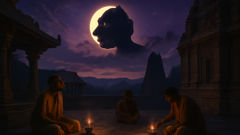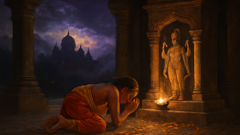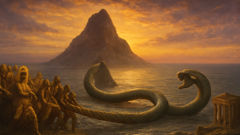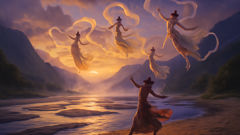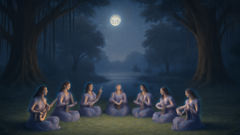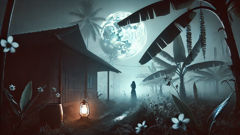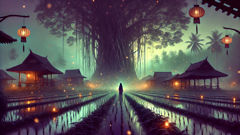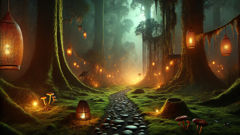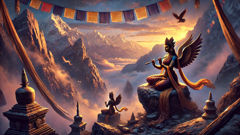Introduction
In the slow measure of a sky watched by temple bells and fishermen, the name Rahu arrives like a shadow across the face of the sun. Even if the word itself rings ancient, the image it calls up is immediate and cinematic: a dark head hung in the heavens, an open mouth hungry for light, an unfinished body trailing somewhere out of sight. That image is the residue of a story told at night and at dawn, told by parents at hearthside and by priests under stone columns, told in the margins of cosmology and in the careful diagrams of astrologers. It is a myth that explains an astronomical event while also asking a wider question — what becomes of beings who grasp at immortality? The story of Rahu opens with desire and deception, moves through the ceremony of the gods and the churning of the ocean, reaches a moment of violent justice, and does not end with the act of decapitation. Instead it becomes a lesson spoken in eclipses: that certain hungers are endless and that the cosmos answers with cycles.
This retelling draws patterns from Vedic and Puranic retellings and from Buddhist reworkings that place Rahu in different moral frames. It aims neither to flatten sacred nuance nor to render a single definitive 'version'; rather, it invites you to stand beneath the same darkening sky and listen to the arguments of gods and demons, to watch the cleverness that unravels into punishment, and to recognize how communities in India and across Asia made sense of rare celestial moments by weaving them into human lives. Through vivid description and careful attention to cultural details — the ringing brass of a temple bell, the lacquered face of a moonlit river, the spice-scented air where fishermen pull in nets at dawn — the tale becomes more than myth: it becomes atmosphere, a living story with teeth and a heartbeat. As we move through the telling, notice how Rahu changes from an aspiring immortal to an emblem of cyclical fear and fascination. Notice the shifting tones — sometimes reverent, sometimes comic, sometimes tragic — and how they echo both Hindu and Buddhist sensibilities toward cosmic order. In the end, the darkness that Rahu brings is not merely a swallowing; it is a question that the world continues to answer with light.
The Cosmic Thirst: Churning the Ocean and the Theft of Immortality
The world that produces Rahu is a world of exchange — gods barter favors, demons scheme with whispered treaties, and the sea itself offers up riches when treated with ceremony and cudgel. In many versions of the tale, Rahu’s story emerges from the great event known in Sanskrit as Samudra Manthan, the churning of the ocean of milk. It is an image that holds both physical labor and metaphysical longing: gods and asuras (demons) working together, ropes braided around the great mountain Mandara as it turns beneath the sea, a vast axis where strength and wit decide the edges of the cosmos.
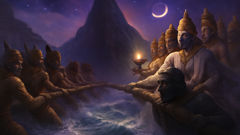
The churning produces wonder: divine physicians and herbs of immortality, dazzling shells and the goddess Lakshmi, the moon like a pale bead thrown into the night. From that froth there also arises the amrita, the nectar of immortality. But in the world of gods and demons, compassion and cunning move in the same space, and where gods arrange for order, an asura will often find a way to bend it. One such asura, whose name comes to us as Rahu, is not a crude brute but a creature of hunger and calculation. Some tellers make him a shadow of the asuras at large, a sense that even in the most cooperative ventures, an old enmity simmers. Others give Rahu a fuller identity: a demon born of primeval lineage, ambitious and envious of the gods’ longevity. The amrita is poured for the gods to drink, each cup passing from hand to glinting hand, until the shape of fortune itself has been consumed by divine mouths. It is at this precise seam — when the last drops tremble between fingers and fate — that Rahu acts.
In one of the most vivid moments, rhythmic with priestly chant and oceanic spray, Rahu dons a disguise. He takes the form of a god and slips into the line of immortals, hiding in the shadow cast by the others. The tale delights in the audacity of this deception: Rahu, in borrowed light, sits among the gods and sips the nectar. For a heartbeat the asura attains the impossible: the body that drank does not feel death's reach, does not feel the aging that binds mortals and demons alike. But truth in myth is stubborn. The sun and the moon — Surya and Chandra — recognize the intruder not by his face but by the pattern of the amrita on his lips and neck. They cry out. Their shout is not merely gossip; it is a ritual obligation. The gods, led by Vishnu in his role as preserver, are swift. In that moment the cosmic balance is restored, but not gently. Vishnu lifts his chakra or takes a blade and with one decisive cut severs Rahu’s head from his body. The body tumbles away, lost to the ocean's dark belly, while the head remains alive, tasting immortality just enough to refuse death.
There is something both comic and terrible in this frozen head. It lives, but only in one half. The body below no longer commands breath; the head above knows perpetual longing. The gods rename it Rahu, a name that will be spoken when the sky blacks over. The severed head, though bereft of limbs, does not submit to finality. Instead it gains a peculiar power: an unending appetite and a cosmic grievance. The presence of this head raises questions the ancients enjoyed asking — how can immortality be both a gift and a malediction? How does the act of cheating death create a new form of punishment? That the head becomes a force that seeks to consume light marks the tale's transition from a localized act of theft to a recurring cosmic event. Rahu does not simply die; he becomes a perpetual shadow.
In the cultural imagination, this origin ties closely to rituals of warning and ritual response. In villages where people watch eclipses, they recall not only the astronomy but the moral grammar of the tale: deception is detected, order asserted, but consequences ripple onward in strange forms. The story supplies a moral double-take — cunning brings near-victory, but it also summons a fate worse than death: an eternity of partial existence. The scene of the churning and the theft is thus both origin myth and parable, offering an ancient audience a reason to hush and to watch the sky with both fear and attention.
Yet the tale does not stop with punitive detachment. There is empathy in some tellings, almost a tragic tenderness when one imagines a living head adrift, watching the world it can no longer truly belong to. The moon and sun become both witnesses and victims; they will be swallowed in due time, but they are also the actors who called out the fraud. That ambivalence — between justice served and the transformation of justice into ceremonial fear — is what makes Rahu a figure of both horror and human fascination. The narrative now angles toward a final, ritualized explanation: when the head hunts for the sun or moon, it does not always succeed, but sometimes it fits its open mouth over them long enough that the light dims. People on earth shout, beat drums, and light lamps; they perform the acts their ancestors performed to drive away the shadow. It is not only an astronomical account but an enactment of the story itself, repeated whenever the heavens echo Rahu's hunger.
The Decapitation and the Eternal Pursuit: Eclipses, Ketu, and Cosmic Order
Once the head is severed, the cosmos has to make a new home for this anomaly. Mythic imagination is rarely content to leave a curious fact unexplained: if a living head floats like a small dark moon, what does it become in the celestial register? Different traditions answer with layered solutions. In much of Hindu telling, Rahu remains a head; the body that once belonged to it becomes Ketu, another strange entity associated with comets and the shadowy nodes of the moon. The two together — Rahu and Ketu — are known in Jyotisha (traditional Hindu astrology) as the lunar nodes, points where the moon's orbit crosses the sun's path. These are not merely astronomical markers but moral actors, cosmic personalities who govern misfortune and destiny.
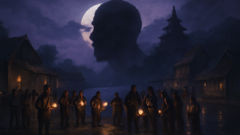
The image is satisfying: the head chases the sun and moon in endless revenge, snatching at them whenever they pass across its path. When the mouth clamps down, light is swallowed and the sky darkens; when the sun or moon slips free, light returns and life continues. In some versions, the swallowing is temporary because the knocked-off head cannot swallow the full body it desires; the sun or moon slips out, but the memory of being devoured remains in the world as eclipse. For small communities, eclipses become a calendar of ritual: children are brought indoors, livestock attended to, pregnant women shielded by cautionary rites. Priests recite mantras, cook in sealed vessels, and recite protective chants. The world is at once pragmatic and poetic — food is saved from spoilage, and myths are repolished like ritual jewels.
Buddhist sources, engaging with the same imagery, sometimes adjust the moral compass. In Buddhist cosmography, Rahu may appear as a figure who is less the villain and more a symptom of ignorance (avidya) and desire (tanha). The metaphor shifts: Rahu's eternal hunger is like the mind's boundless craving, which, even when cut by insight, can persist in new shapes. Where Hindu versions emphasize ritual correction and the restoration of cosmic order by Vishnu's decisive intervention, Buddhist tellings often use Rahu to show how clinging reproduces suffering. In either frame, however, the spectacle is communal: societies create responses that blend superstition, folk logic, and practical measures. Lamps are lit, vessels are covered, chants are recited; the eclipse becomes the hour in which folklore and social care intersect.
Astronomers and astrologers translated these images into systems of knowledge. The nodes of the moon — mathematics of orbital intersections — receive mythic housing by being named Rahu and Ketu. Ancient Indian astronomers tracked the cycles and provided rules for predicting eclipses, even while communities continued to speak of the swallowing head. In this way myth and empirical observation coexisted, each serving different needs. Where the astronomer measured and predicted, the storyteller explained meaning: why darkness falls without wind, why day becomes night without storm. The dual language assured that people could both anticipate the event and ritualize it. That duality persists today: modern skywatchers can calculate the path of totality across continents while temple bells and village drums still mark the eclipse’s approach.
There is a human tenderness woven into these celestial images. Rahu is not only a monster but a reminder of the fragility of order and the cost of hubris. He is a figure who teaches by absence; the light is taken away to show how much depends on it. In the quieter moments, the story prompts reflection about who we are when the familiar is removed. Farmers who watch their fields in an unexpected dusk remember that systems can fail — but the myth also tells them how to respond together. Priests and laypeople, astronomers and storytellers all participate in a ritual economy of explanation and solace. This is why, though modern science explains eclipses, the image of Rahu continues to hold power. It is not a refusal of reason but an addition to it: a mythic vocabulary for fear, for lesson, for community.
The figure of Rahu also accents the notion of liminality — a being neither wholly divine nor wholly monstrous, neither dead nor fully alive. The head's partial life models a world in which boundaries can be transgressed and then ritualized. In a way, every eclipse is a public recounting: Rahu runs his mouth across the face of light and vanishes, but the echo of the act remains in songs and in art. Sculptors carved darkened discs into temple stones, painters drew a hungry head against the sun, and poets used the image as an emblem for political or spiritual overreach. Medieval and early modern astrologers wrote treatises about the effects of Rahu on kings and on crops; travelers recorded local practices — how a Tamil fishing village might respond differently from a Nepali monastery. Across centuries and geographies, the myth accumulated local detail while keeping the core drama intact: a theft, a severing, and an eternal pursuit that turns the sky into a stage.
Finally, there is an ethical echo that moves the tale from myth to lesson. The gods did not allow the deception to stand; they restored order, but their restoration created an immortal wound. In that wound the world finds a recurring test: when darkness comes, do people fall into superstition, or do they act as communities who care for one another? The story subtly proposes that the right response to cosmic interruption is collective attention. That is why rituals around eclipses often emphasize both protection and compassion — food saved and shared, prayers for those who fear, lamps lit to banish panic. Rahu’s mouth is thus not only an omen but a prompt: when light is swallowed, what will we do with the time of shadow?
Conclusion
When the sky darkens and a community falls silent, the story of Rahu arrives not as a lecture but as a companion — a way to carry fear toward ritual, to knit practical behavior to symbolic meaning. The legend asks us to consider what immortality would cost and what deception yields; it gives us a dramatic narrative to name a predictable astronomical alignment, and by doing so it offers comfort. Knowing there is a story makes the eclipse feel less random and more like something the world has rehearsed before. Beyond explanation, Rahu remains a study in paradox: the head that lives apart, the asura who is both punished and made potent, the figure who teaches people to gather. Across centuries, Hindu and Buddhist tellings have shaped him into slightly different moral mirrors, but in both traditions the image persists because it answers a deep human need — to transform unsettling natural events into shared narratives that instruct and unite. Watch the darkened sun or moon and you trace the arc of a myth: a theft at the ocean, a sacred shout, the decisive cut, and the head forever hungry. In that cycle there is both warning and wisdom: that some hungers can never be sated, that order is fragile, and that light returns if people bind themselves to each other while it is gone. The legend of the Asura Rahu therefore remains not merely an account of eclipses, but a cultural compass, reminding every listener that when the heavens fold into shadow, community and story are the lamps we carry until dawn returns.

